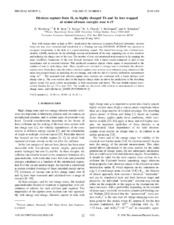| dc.creator | Weinberg, G. | |
| dc.creator | Beck, B. R. | |
| dc.creator | Steiger, J. | |
| dc.creator | Church, David A. | |
| dc.creator | McDonald, J. | |
| dc.creator | Schneider, D. | |
| dc.date.accessioned | 2011-09-08T21:35:48Z | |
| dc.date.available | 2011-09-08T21:35:48Z | |
| dc.date.issued | 1998 | |
| dc.identifier.citation | G. Weinberg, B. R. Beck, J. Steiger, David A. Church, J. McDonald and D. Schneider. Phys.Rev.A 57 4452-4461 1998. "Copyright (1998) by the American Physical Society." | en |
| dc.identifier.uri | http://dx.doi.org/10.1103/PhysRevA.57.4452 | |
| dc.identifier.uri | https://hdl.handle.net/1969.1/126537 | |
| dc.description | Journals published by the American Physical Society can be found at http://publish.aps.org/ | en |
| dc.description.abstract | Ions with charge states as high as 80+, produced in the Lawrence Livermore National Laboratory electron beam ion trap were extracted and transferred to a Penning ion trap (RETRAP). RETRAP was operated at cryogenic temperature in the field of a superconducting magnet. The stored low-energy ions collided occasionally with H-2 molecules in the ultrahigh-vacuum environment of the trap, capturing one or two electrons and reducing the charge state of the ions. The number of ions was monitored nondestructively by ramping the axial oscillation frequencies of the ions through resonance with a tuned circuit composed in part of trap capacitance and an external inductor. This produced resonance signals whose square is proportional to the number of ions in each charge state. These signals were recorded vs storage time to determine the electron-capture rates. From these rates the relative electron-capture cross sections were obtained using estimates of the mean ion energies based on modeling the ion storage, and with the aid of a density calibration measurement using Ar11+. The measured total electron-capture cross sections are consistent with a linear increase with charge state q. The cross-section data for the highest charge states lie above the predictions of the absorbing sphere model, but agree within uncertainties in both experiment and theory. The true double-capture cross-section fraction for q>35 is near 25%. The results are discussed with relation to measurements on lower charge states, and with theory. | en |
| dc.language.iso | en | |
| dc.publisher | American Physical Society | |
| dc.subject | CROSS-SECTIONS | en |
| dc.subject | 2-ELECTRON TRANSFER | en |
| dc.subject | MERGED-BEAMS | en |
| dc.subject | COLLISIONS | en |
| dc.subject | SLOW | en |
| dc.subject | AR | en |
| dc.subject | ATOMS | en |
| dc.subject | HE | en |
| dc.subject | TRANSITIONS | en |
| dc.subject | PARTICLE | en |
| dc.subject | Optics | en |
| dc.subject | Physics, Atomic, Molecular and Chemical | en |
| dc.title | Electron capture from H-2 to highly charged Th and Xe ions trapped at center-of-mass energies near 6 eV | en |
| dc.type | Article | en |
| local.department | Physics and Astronomy | en |


